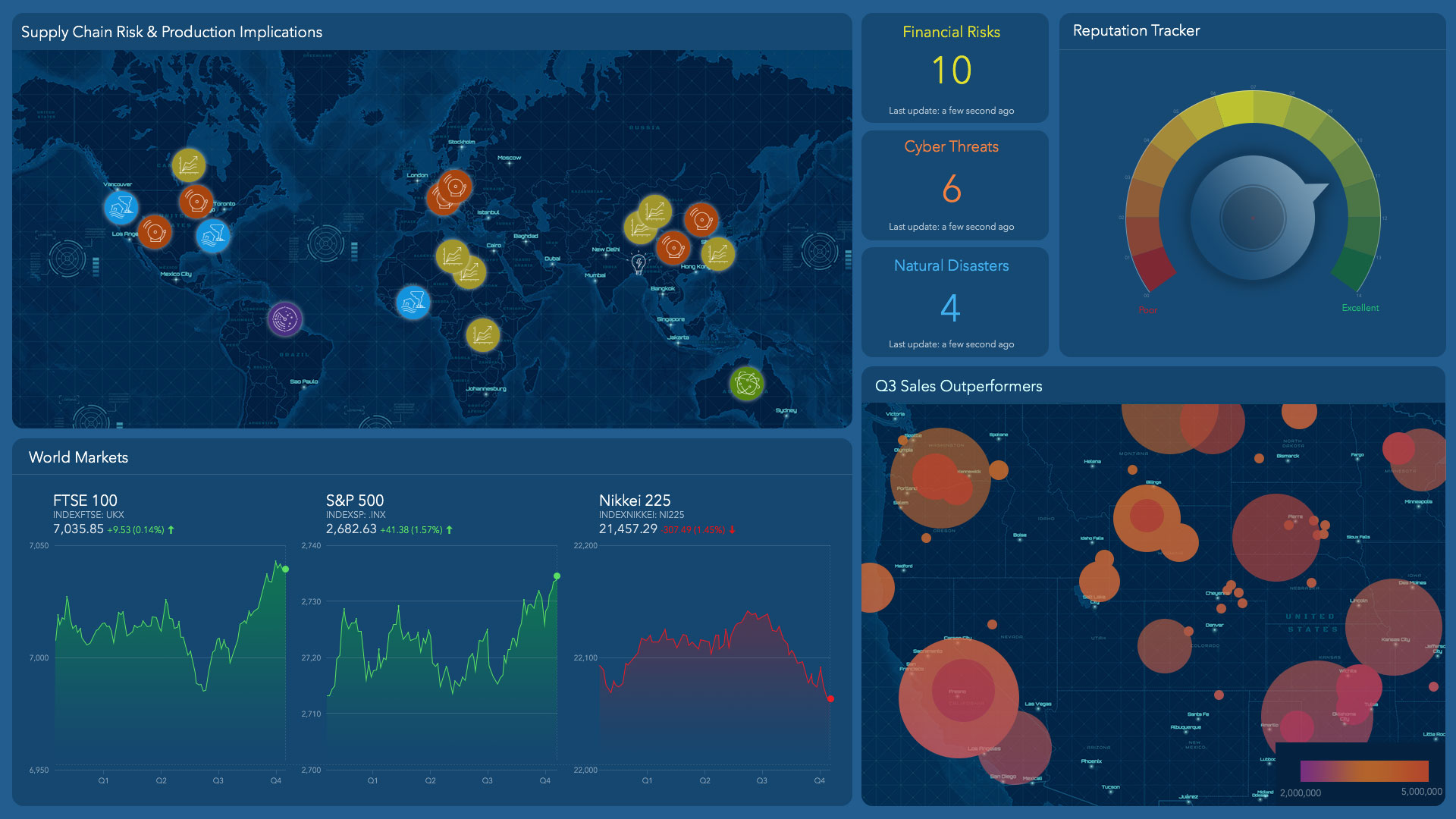As digital transformation spawns larger and more varied datasets, companies willing to expose actionable insights across the enterprise are realizing better customer experiences and making smarter decisions.
These pioneering companies democratize data to more of their employees with the help of analytics applications that require little training. Tools such as a geographic information system (GIS), once the exclusive province of data scientists, are now being extended to employees enterprise-wide. And since nearly all forms of business data are tied to location—where are field crews working, where are competitors gaining market share, where to place new utility infrastructure—leading companies are investing in employee-friendly GIS platforms that make business operations more data-driven.
With democratized data and location intelligence powered by GIS and other tools, employees at all levels are empowered to make better decisions faster.
Data Powers Intelligent Interactions
For employees, the days of waiting on a small group of data scientists to provide location intelligence are waning. The market for low-code development platforms that deliver data analysis to non-coders is already valued in the billions, and is growing 50 percent each year, according to Forrester.
Matt Zenus, global vice president for data management at SAP, noted in a recent podcast that companies are embracing data democratization as part of a larger cultural shift toward data-driven business strategy:
We’re at a convergence point where there isn’t a lack of data anymore, but the demands on data are huge. What’s exciting for me is to see the innovative organizations that know how to take advantage of all this data to actually create insights. When those organizations make decisions on those insights and actually make them part of their businesses processes, they’re going to win.
Recent successes of several growth-focused companies reveal how data democratization pays dividends throughout the business world.
Serving up Information to Employees
Four years ago, one prominent US restaurant chain’s data was locked up in silos. In one silo, a team of nine data experts created GIS-based maps to identify potential new store locations—a common application of the technology.
At the time, the company had just become one of the 10 largest restaurants in the US. Today, it’s among the top five chains, and still growing.
Executives supported that growth in part by breaking down data silos and disseminating information throughout the organization, helping employees make better, faster decisions. The process relied heavily on lightweight, often mobile apps that most employees find intuitive and quick to navigate. From its original corps of nine users, GIS technology now reaches hundreds of company professionals across 40 departments, many of whom use its location intelligence on a daily basis.
The system is fed in part by a group of field professionals who analyze the competitive market around each restaurant. Through mobile GIS apps, they make detailed assessments of competitor activities noting where and when new stores are being built, along with the dynamics of the retail environment each competitor occupies.
That data is delivered in real time to strategic planners in the office. They combine the information with sophisticated demographic analyses to support multimillion-dollar investment decisions about where to open new stores and how to counter competitor moves.
“Now, without people knowing they’re actually leveraging GIS, we’ve effectively turned many people across the organization into a GIS analyst,” says a manager who helped shepherd the project.
Such collaborative use of precision data and human insight has vaulted the company to one of the highest rates of per-store sales in the industry.
Upending Conventional Wisdom on Data
At one of the world’s largest oil and gas companies, data sequestration had become a way of life. The organization took a “better safe than sorry” approach to data governance—only a privileged few could access most information, and it rarely crossed departmental boundaries.
But under innovative leadership, even a company with more than $100 billion in revenue and a prime spot in the Fortune 50 can change course. Over several years, executives undertook a digital transformation that reached every corner of the business, including the geographic information system that helps the company manage nearly all its operations. Its drillers use the system to understand where oil lurks underground. Maintenance crews map efficient routes through vast, uncharted oil fields. And decision-makers consult the system looking for fertile ground for new investments.
Before initiating the GIS overhaul, however, leaders paused to consider the status quo. What they found, according to one VP close to the project, was a brand of conventional wisdom that was far from reality.
“The reality is that 95 percent of the geospatial data we use can be shared across the entire organization,” he explains. “Only a few key datasets need to be locked down.”
Once this was clear, the corporate mindset changed drastically, and leaders made data open by default, keeping just five percent of it locked down. That move created a virtuous cycle of information exchange and innovation.
“We’ve seen many instances where a dataset that was considered basic information for one team turns out to be very valuable to another team,” he notes. Upstream teams began to collaborate with downstream teams, and the data-sharing trend spread through the organization. That, the VP says, “led to new efficiencies, insights, and business opportunities.”
An Ambitious Growth Plan Demands Better Data
When executives at X5 Retail Group, the second largest retailer in Russia, set the lofty goal of opening 2,500 new stores in one year, they knew they had very little room for error. The company was already growing at a fast clip, but the new goal was five times its previous high mark. To reach it, decision-makers needed reliable data, quick analyses, and an impeccable sense of market potential to ensure profitability.
“We want regional director[s] to focus the attention of the whole operating team on a high-quality opening of each new store,” explains Igor Pletnev, the company’s strategic business development director. “To us, it’s not the quantity, but the quality that matters.”
To succeed on both counts, X5 needed to expand the number of professionals involved in site selection and outfit them with location intelligence to make fast, profitable decisions. Soon, GIS apps were a constant companion for almost 800 employees in the organization. They used its data to analyze market characteristics such as per capita income and population density; to decide the best assortment of products for each store; even to predict how much revenue each location would generate.
By empowering employees to input and access data from a central source, GIS delivered the insight decision-makers needed to move quickly and efficiently. This radically democratized approach helped the retail giant open more than 5,000 grocery and convenience stores in just two years, sending the company’s market cap past $6 billion.
“Those newly opened stores were good openings, high-quality openings,” Pletnev says. “The percentage of mistaken decisions is very low.”
Toward a More Intelligent Enterprise
Like most successful enterprise strategies, data democratization thrives on the combined power of people and technology.
Organizations that embrace digital transformation, and have the gumption to disrupt traditional mores on data access, can separate themselves from the competition. When data is entrusted to employees across the enterprise, business intelligence increases at all levels—from the boardroom, to operational planners, to the edge where the organization connects with the customer.











